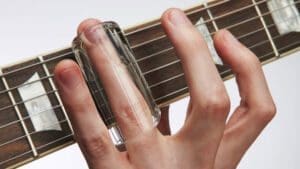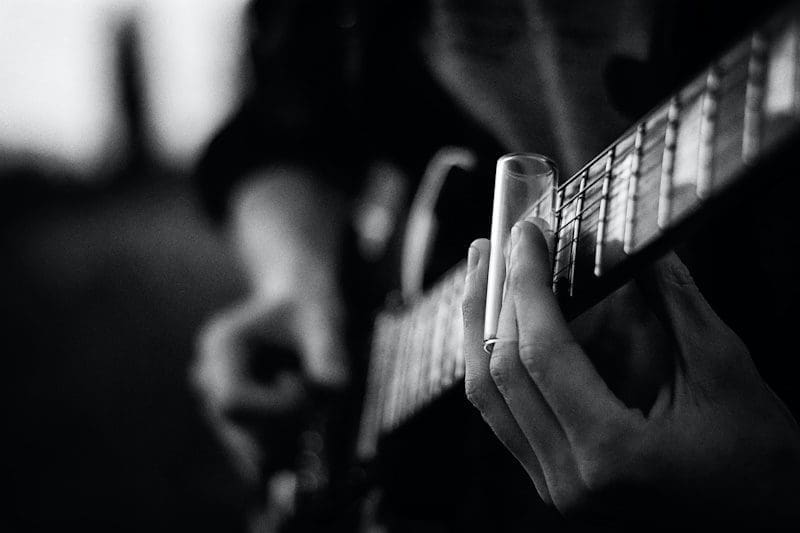Have you ever wondered about slide guitar, how it’s played, and the techniques involved? Read on, and we’ll give you an insight.
Table of contents
- The Origin of Slide Guitar
- Famous Guitar Players who play Slide
- Commonly asked questions and answers that people ask about slide guitar.
- What is a slide guitar?
- Why Slide is so Popular
- Is it difficult to play slide?
- How does slide guitar differ from regular guitar playing?
- What types of slides are commonly used?
- What kind of guitars are suitable for slides?
- Do I need a specific tuning for playing slide?
- Is playing slides challenging to learn?
- What musical genres commonly feature slides?
- How do I achieve vibrato and other slide techniques?
- Can I use a regular guitar for slide playing?
- Who are some famous slide guitar players?
- Are there specific exercises to improve playing slide?
- Can a slide be used for both electric and acoustics?
- What are some common mistakes beginners make when playing slides?
- How do I choose the right Slide for my playing style?
- Can I incorporate slide techniques into my playing style?
- Conclusion
The Origin of Slide Guitar
Slide Guitar is a familiar kid on the block. Its roots go back to the late 19th century in the Mississippi Delta region of the United States. Back then, musicians didn’t have fancy guitar accessories, so for a slide, they used whatever was handy, e.g., a knife, bottleneck, or even a metal tube to slide along the top of the guitar strings. The sliding technique creates that distinct, emotive sound we associate with slide guitar.
How Slide is Played


Playing with a slide is different than your run-of-the-mill guitar-playing technique; it’s quite a departure.
Here’s the main difference: instead of fretting the strings directly with your fingers, a slide, traditionally made of glass, metal, or ceramic material, is worn on just one finger.
This Slide is pressed lightly against the strings, and while doing so, the player’s hand is moved up and down the neck and fretboard of the guitar. It’s all about controlling the pressure and angle of the Slide to achieve different tones and emotions. That’s it in a nutshell. However, it’s definitely easier said than done.
Guitar Setup for Slide
Now, you can’t grab any old guitar and start sliding away. Ok, you could, but ideally, you must set up your guitar first. Most slide players prefer that their guitars be set up with a higher action (the height between the strings and the top of a fret). The guitars is commonly set up with a higher-than-usual action to prevent the Slide from buzzing against the frets.
Also, slide players commonly use various tunings to get those unique sounds and for slide playing.


Musical Genres and Slide
Slide guitar is a versatile technique tool that’s found its way into various musical styles. Blues? Absolutely. Country? For sure. Rock? You bet. From the Delta blues of Robert Johnson to the country twangs of Jerry Douglas, slide guitar has made its mark across a plethora of genres, adding that extra layer of expressiveness and character to the music.
Various Slide Styles


There’s no one-size-fits-all when it comes to slide-playing styles. Each player brings their flavor to the table. You’ve got your classic blues Slide with its sad, soul-stirring tunes. Then there’s the country slide, famous for its twangy, toe-tapping melodies. And let’s remember the rock slide, adding grit and power to those electric guitar riffs.
Famous Guitar Players who play Slide
Slide guitar has its heroes, legends who’ve carved their names into music history with unparalleled slide prowess. Think of the iconic Duane Allman, whose slide work with the Allman Brothers Band is the stuff of legend.
Evolution of Slide Techniques
In the early days, as slide guitar gained popularity, guitarists started experimenting with different techniques, pushing the boundaries of what the guitar could do. Vibrato, for instance, became a hallmark move, adding a shimmering effect to the notes.
Some players explored intricate fingerpicking and combined that with their slide style. Over time, these techniques evolved, contributing to the diverse range of sounds achievable with a slide.
Modern Innovations and Slide
The beauty of music lies in its evolution. Slide guitar is no exception. In recent years, advancements in technology have brought innovations in slide playing. From specially designed slides with improved materials for better tone to pedals and effects that expanded upon what could be done sonically.
Commonly asked questions and answers that people ask about slide guitar.
What is a slide guitar?
A slide is traditionally made of glass, metal, or ceramic, is worn on one finger, and used to glide along the strings of a guitar, producing distinctive and expressive sounds.
Why Slide is so Popular
Well, for starters, it’s unique. That haunting, expressive sound resonates deep within the listener’s soul.
Is it difficult to play slide?
Ah, the million-dollar question. Mastering slide guitar isn’t a walk in the park. It takes practice, patience, and a keen ear to nail those precise slides and dynamic bends. Coordinating the slide, controlling the pressure, and maintaining pitch accuracy while keeping cool are no small feats. The challenge is part of the fun, right?
How does slide guitar differ from regular guitar playing?
Instead of directly pressing strings onto frets to produce notes. Also, the Slide is used to create the pitches by lightly touching the strings. This technique allows for smooth gliding between notes, producing a unique sliding sound.
What types of slides are commonly used?
The most common materials used for slides are glass, metal, and ceramic. Each material offers a different tone and feel, influencing the sound produced.
What kind of guitars are suitable for slides?
Guitars with higher action (greater distance between strings and fretboard) are preferred for Slide playing to avoid buzzing against the frets. Slide players often favor resonator guitars and guitars with specific neck profiles.
Do I need a specific tuning for playing slide?
Standard guitar tuning can be used. However, many players may use alternate tunings to make slide playing easier or to achieve different sounds. Open tunings like Open G or Open D are very popular with guitar players as well as slide guitarists.
Is playing slides challenging to learn?
Mastering slide playing requires practice and patience, especially in controlling the Slide’s pressure intonation and creating smooth transitions between notes.
What musical genres commonly feature slides?
Slide guitar is prevalent in blues, country, rock, and folk music. It’s also found in various contemporary music.
How do I achieve vibrato and other slide techniques?
Vibrato and other techniques are achieved by manipulating the Slide’s pressure, angle, and finger movements while sliding along the strings. Practice and experimentation are key to mastering these techniques.
Can I use a regular guitar for slide playing?
Yep, a regular guitar can be used for slide playing; however, adjustments to the guitar setup, including raising the action or using a larger string gauge, are typical.
Who are some famous slide guitar players?
Prominent slide guitarists include Duane Allman, Ry Cooder, Bonnie Raitt, Derek Trucks, Sonny Landreth, and Robert Johnson, to mention a few. These are, among many others, who have significantly influenced slide-playing.
Are there specific exercises to improve playing slide?
Practice sliding between notes, controlling intonation, and working on vibrato techniques are essential exercises. In addition, ear training and learning slide solos can be beneficial.
Can a slide be used for both electric and acoustics?
Absolutely! Slide is versatile and can be used in acoustic and electric guitar setups, each offering a unique sound and tonal characteristics.
What are some common mistakes beginners make when playing slides?
Common mistakes include excessive pressure on the strings, muted notes or sharp pitches, lack of control in slide movements, and improper slide positioning on the strings.
How do I choose the right Slide for my playing style?
Experimenting with different slide materials, sizes, and weights is crucial to finding the Slide that suits your playing style and comfort. It often comes down to personal preference.
Can I incorporate slide techniques into my playing style?
Absolutely! Even if you’re not solely a slide guitarist, learning slide techniques can add depth and diversity to your overall guitar playing, enhancing your musical expression. In addition, the trick is to start small, with nothing to flash initially. Also, you will find that your style will develop in time.
Conclusion
Let your fingers glide, and let the magic unfold!



